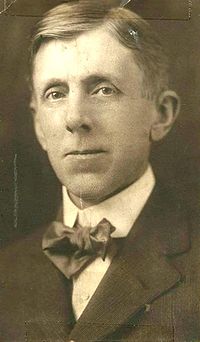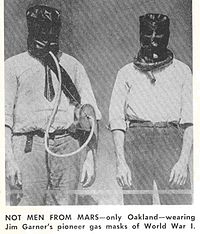
James Bert Garner
Encyclopedia


Chemical engineering
Chemical engineering is the branch of engineering that deals with physical science , and life sciences with mathematics and economics, to the process of converting raw materials or chemicals into more useful or valuable forms...
and professor at the Mellon Institute of Industrial Research
Mellon Institute of Industrial Research
Mellon Institute of Industrial Research, founded in 1913 by Andrew W. Mellon and Richard B. Mellon, merged with the Carnegie Institute of Technology in 1967 to form Carnegie Mellon University in Pittsburgh, Pennsylvania, United States...
from 1914 until his retirement in 1957. He is credited with the invention of a World War I gas mask
Gas mask
A gas mask is a mask put on over the face to protect the wearer from inhaling airborne pollutants and toxic gases. The mask forms a sealed cover over the nose and mouth, but may also cover the eyes and other vulnerable soft tissues of the face. Some gas masks are also respirators, though the word...
in 1915.
After reading an account of a gas attack
Poison gas in World War I
The use of chemical weapons in World War I ranged from disabling chemicals, such as tear gas and the severe mustard gas, to lethal agents like phosgene and chlorine. This chemical warfare was a major component of the first global war and first total war of the 20th century. The killing capacity of...
by the German Army on Canadian and French troops on April 22, 1915 at Ypres, Dr. Garner hypothesized that chlorine gas had been used. Based on research he had performed while at the University of Chicago
University of Chicago
The University of Chicago is a private research university in Chicago, Illinois, USA. It was founded by the American Baptist Education Society with a donation from oil magnate and philanthropist John D. Rockefeller and incorporated in 1890...
he believed that activated charcoal would adsorb
Adsorption
Adsorption is the adhesion of atoms, ions, biomolecules or molecules of gas, liquid, or dissolved solids to a surface. This process creates a film of the adsorbate on the surface of the adsorbent. It differs from absorption, in which a fluid permeates or is dissolved by a liquid or solid...
the gas. After performing a successful test using two of his associates who were exposed to gas in a sealed room while wearing Dr. Garner’s gas mask, the results were turned over to the British government. In America thousands of gas masks were produced for American as well as Allied troops. Mine Safety Appliances
Mine Safety Appliances
Mine Safety Appliances, or MSA, is a maker of sophisticated safety products that help protect workers who may be exposed to a variety of hazardous conditions...
was a chief producer. His mask was later used widely in industry.
Accomplishments
Garner graduated from Wabash CollegeWabash College
Wabash College is a small, private, liberal arts college for men, located in Crawfordsville, Indiana. Along with Hampden-Sydney College and Morehouse College, Wabash is one of only three remaining traditional all-men's liberal arts colleges in the United States.-History:Wabash College was founded...
in 1893 with a Bachelor of Science degree and studied under the renowned Dr. Alexander Smith
Alexander Smith (chemist)
Alexander Smith was an American chemist, born in Edinburgh, Scotland. He graduated from the University of Edinburgh in 1886 and received the degree of Ph.D. at Munich in 1889. After coming to the United States, Smith was professor of chemistry and mineralogy at Wabash College and later a faculty...
.
In 1895, after receiving a Master of Science degree from Wabash and teaching there, he went at Smith's invitation to the University of Chicago
University of Chicago
The University of Chicago is a private research university in Chicago, Illinois, USA. It was founded by the American Baptist Education Society with a donation from oil magnate and philanthropist John D. Rockefeller and incorporated in 1890...
for a teaching appointment. This is where he was first exposed to the principle he later used in a charcoal gas mask. It was part of his duties to set up experiments on the lecture tables. In an effort to find a demonstration that would seem especially dramatic, he turned to a little used one from a well-known source-book, G. S. Newth
George Samuel Newth
George Samuel Newth was an English chemist, best known for a series of popular chemistry books.- Biography :Born in Plymouth, England, Newth was the son of Dr. the Rev Samuel Newth , principal of New College London, a noted Biblical scholar, non-conformist and mathematician.Newth's address in 1871...
's Chemical Lecture Experiments.
What his students saw was a long cylinder filled with mercury
Mercury (element)
Mercury is a chemical element with the symbol Hg and atomic number 80. It is also known as quicksilver or hydrargyrum...
, immersed in a vessel also filled with mercury. When ammonia
Ammonia
Ammonia is a compound of nitrogen and hydrogen with the formula . It is a colourless gas with a characteristic pungent odour. Ammonia contributes significantly to the nutritional needs of terrestrial organisms by serving as a precursor to food and fertilizers. Ammonia, either directly or...
was generated through a glass delivery tube, the mercury in the beaker came down into the container vessel. That was when Garner applied the touch of drama. When he placed a stick of activated charcoal into the vessel the tube of the mercury again shot to the top of the cylinder.
Dr. Garner's purpose was to fix in his students' memory a mental picture of how ammonia gas was adsorbed by wood charcoal. It made an even more lasting impression upon the instructor but it was a good many years before he was able to make use of it." .
In 1897, Garner received a Ph.D. in Physical [Organic] Chemistry and became head of the Chemistry Department at Bradley Polytechnic Institute
Bradley University
Bradley University, founded in 1897, is a private, co-educational university located in Peoria, Illinois. It is a small institution with an enrollment of approximately 6,100 undergraduate and postgraduate students and a full-time faculty of approximately 350....
in Peoria, Illinois where he taught until 1901 and continued these experiments.
From 1901 to 1914, Garner served as the head of the Chemistry Department at Wabash College
Wabash College
Wabash College is a small, private, liberal arts college for men, located in Crawfordsville, Indiana. Along with Hampden-Sydney College and Morehouse College, Wabash is one of only three remaining traditional all-men's liberal arts colleges in the United States.-History:Wabash College was founded...
. "For 14 years under Dr. Garner the Wabash chemistry department showed one of its greatest periods of productivity with at least 18 future Ph.D's graduated" (Ibid, p. 8).
The following excerpt relates to Garner's research into the gas mask.
Dr. James Bert Garner and his first gas mask was and is a Pittsburgh story, one of the many unpublicized ones which have taken place behind the walls of Oakland's Mellon Institute. Dr. Garner had a large family and needed a post with a higher income. He found it at the Mellon Institute in 1914 where he was assigned to a Metals Research Fellowship.[Ibid, p. 8-9].
While working on methods of recovering sulphur dioxide from copper smelter gases, something happened to recall his favorite experiment at the University of Chicago. A Pittsburgh newspaper account (no exact reference) of action near Ypres, Belgium,, in 1915 actually was what led Dr. Garner toward his most notable scientific contribution. The article quoted a Cap. Bertram of the Eighty Canadian Battalion who reported 'a white smoke arising from the German trenches to a height of about 3 feet. Then, in front of the white smoke appeared a greenish cloud which drifted along the ground to our trenches, to rising more than about 7 feet from the ground. Men in the trenches were obliged to leave and a number of them were killed by the effects of the gas.
[Playing a hunch from his current work at Mellon Institute he] "made use of the prepared charcoal technique of his lecture assistant days at the Univ. of Chicago. he found that it absorbed sulphur dioxide from the air stream, as well as the ammonia of the experiment....He guessed the British troops were overcome by chlorine gas. This, too, he believed could be adsorbed by activated charcoal. His then current work at the Institute had made use of the prepared charcoal technique of his ... days at the University of Chicago. He found that it adsorbed {not "absorbed"} sulphur dioxide from the air stream, as well as the ammonia of the experiment
In addition to the gas mask, Dr. Garner was also involved in many other discoveries and inventions. For example, in June 1916 Garner patented a process of obtaining gasoline from natural gas, and in July 1936 he patented a process for extracting nicotine from tobacco, in addition to numerous other patents throughout his career.

